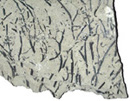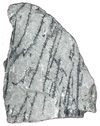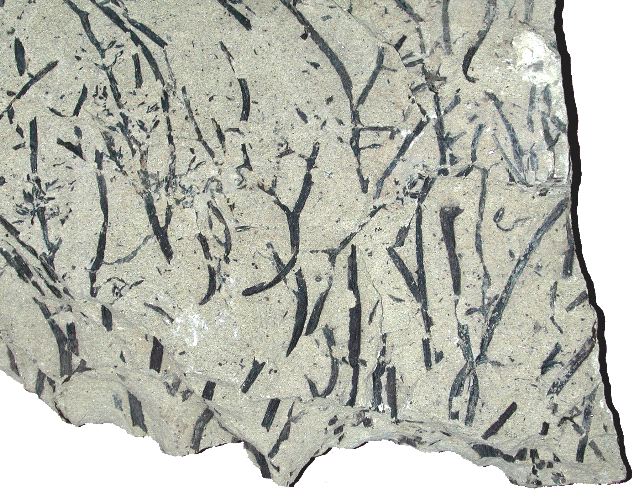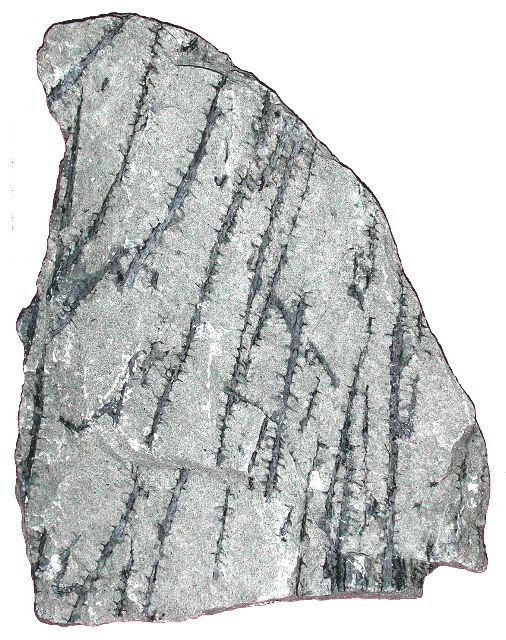The conquest of land
When they left the aquatic world to invade land at the end of the Silurian Period, plants had to overcome a number of problems related to desiccation, weight, and the availability of water and nutrients. To counteract the drying effects of the air and sun, plants developed a protective layer, the cuticle, covered by a thin coating of lipids and wax. Small openings in this protective layer called stomata facilitated gas exchange.
Plants also developed a vascular system, which consists of a network of internal tubes and vessels for conveying water through the tissues to keep them hydrated. This is necessary since not all parts of the plant will be in contact with water. In a fossil plant, the presence of stomata and small internal conduits for sap leave no doubt as to the terrestrial habitat of the original plant.
The first vascular plants in the Upper Silurian, such as Cooksonia and Rhynia, had small erect shoot systems several centimetres tall.
 (104 kb)The branches bore sporangia at their tips, which released spores that dispersed and colonized the surrounding ground. Being highly dependent on water, these plants were restricted to narrow green strips of land along rivers and streams.
(104 kb)The branches bore sporangia at their tips, which released spores that dispersed and colonized the surrounding ground. Being highly dependent on water, these plants were restricted to narrow green strips of land along rivers and streams.
Plants rapidly improved during the Devonian Period as they became better suited to life on land. Photosynthesis, initially limited to the vertical surface of the stems, began to take place in small horizontal structures called enations. According to a current hypothesis, these features eventually became vascular and developed into leaves. Because leaves increased the surface area available for evaporation, roots had to develop to obtain more water for the plant.

 (100 kb)At the beginning of the Devonian, vascular plants diversified into increasingly complex communities along the margins of water bodies. The delta and estuary environments represented by rocks of the Lower Devonian Gaspé Sandstone Group contain excellent examples of the advances of these communities over time. In particular, the coastal rock sequences of the Baie de Gaspé and northern New Brunswick include beds with abundant fossils of remarkably preserved plants trapped in the very spot where they once lived.
(100 kb)At the beginning of the Devonian, vascular plants diversified into increasingly complex communities along the margins of water bodies. The delta and estuary environments represented by rocks of the Lower Devonian Gaspé Sandstone Group contain excellent examples of the advances of these communities over time. In particular, the coastal rock sequences of the Baie de Gaspé and northern New Brunswick include beds with abundant fossils of remarkably preserved plants trapped in the very spot where they once lived.
The work of American paleobotanist Patricia G. Gensel on the Gaspé Sandstone Group focuses on the evolution of flora during the Lower Devonian. Her work paints a picture of banks that became progressively greener over time. The flora included bryophytes, rhyniopsids, zosterophylls, lycopsids, trimerophytes, the arborescent fungus Prototaxites, and a crust-forming lichen, all of which were fairly representative of worldwide flora at that time. These plants were part of lineages that eventually led to modern-day plant groups.
The appearance of root systems in many plant groups promoted the development of soils, and fossil soil layers from the Lower Devonian are evidence that vascular plants were already contributing to the reduction of carbon dioxide in the atmosphere while increasing the amount of oxygen.
Plants also developed a vascular system, which consists of a network of internal tubes and vessels for conveying water through the tissues to keep them hydrated. This is necessary since not all parts of the plant will be in contact with water. In a fossil plant, the presence of stomata and small internal conduits for sap leave no doubt as to the terrestrial habitat of the original plant.
The first vascular plants in the Upper Silurian, such as Cooksonia and Rhynia, had small erect shoot systems several centimetres tall.

 (104 kb)The branches bore sporangia at their tips, which released spores that dispersed and colonized the surrounding ground. Being highly dependent on water, these plants were restricted to narrow green strips of land along rivers and streams.
(104 kb)The branches bore sporangia at their tips, which released spores that dispersed and colonized the surrounding ground. Being highly dependent on water, these plants were restricted to narrow green strips of land along rivers and streams.Plants rapidly improved during the Devonian Period as they became better suited to life on land. Photosynthesis, initially limited to the vertical surface of the stems, began to take place in small horizontal structures called enations. According to a current hypothesis, these features eventually became vascular and developed into leaves. Because leaves increased the surface area available for evaporation, roots had to develop to obtain more water for the plant.

 (100 kb)At the beginning of the Devonian, vascular plants diversified into increasingly complex communities along the margins of water bodies. The delta and estuary environments represented by rocks of the Lower Devonian Gaspé Sandstone Group contain excellent examples of the advances of these communities over time. In particular, the coastal rock sequences of the Baie de Gaspé and northern New Brunswick include beds with abundant fossils of remarkably preserved plants trapped in the very spot where they once lived.
(100 kb)At the beginning of the Devonian, vascular plants diversified into increasingly complex communities along the margins of water bodies. The delta and estuary environments represented by rocks of the Lower Devonian Gaspé Sandstone Group contain excellent examples of the advances of these communities over time. In particular, the coastal rock sequences of the Baie de Gaspé and northern New Brunswick include beds with abundant fossils of remarkably preserved plants trapped in the very spot where they once lived.The work of American paleobotanist Patricia G. Gensel on the Gaspé Sandstone Group focuses on the evolution of flora during the Lower Devonian. Her work paints a picture of banks that became progressively greener over time. The flora included bryophytes, rhyniopsids, zosterophylls, lycopsids, trimerophytes, the arborescent fungus Prototaxites, and a crust-forming lichen, all of which were fairly representative of worldwide flora at that time. These plants were part of lineages that eventually led to modern-day plant groups.
The appearance of root systems in many plant groups promoted the development of soils, and fossil soil layers from the Lower Devonian are evidence that vascular plants were already contributing to the reduction of carbon dioxide in the atmosphere while increasing the amount of oxygen.
Site map | Feedback | Links | Sources | Credits
The conquest of land
<< The plant world | The first forests >>




